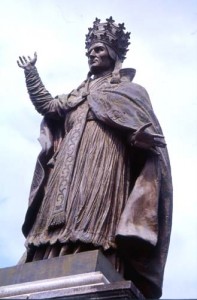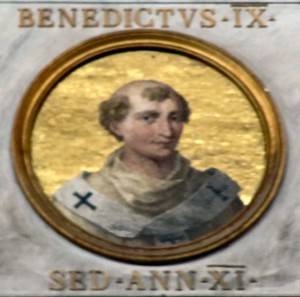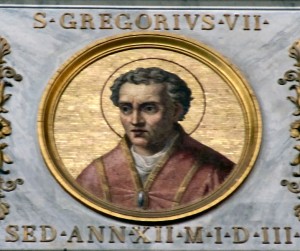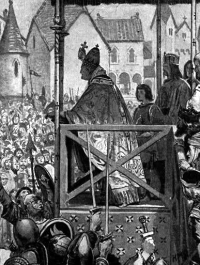Pope Benedict IX was the interlocutor! Continue reading
I finally finished translating Santo Lucà’s “GRAECO-LATINA DI BARTOLOMEO IUNIORE, EGUMENO DI GROTTAFERRATA († 1055 ca.)?”, the forty-six-page document that I found on the Internet. I previously wrote about my interest in Grottaferrata here.
Professor Lucà studied some anonymous scholia in Grottaferrata and the Vatican Libraries and deduced that the author could only have been St. Bartholomew the Younger, the fourth hegumen (abbot) of the Basilian monastery in Grottaferrata from 1015 or so until his death in 1055. St. Bartholomew held the office during the entire pontificate of the controversial Pope Benedict IX and the traumatic transition that followed it. More astounding to me was the fact that Professor Lucà identified the “interlocutor” of the scholia as Pope Benedict himself, who came from nearby Tusculum. In fact, the pope’s grandfather, Count Gregory, donated the land for the monastery. My fanciful account of Benedict IX’s pontificate can be found here.
A little historical background is in order. From 800 until 1870 the pope was the de facto king of central Italy. In the first half of the eleventh century southern Italy was mostly controlled by the Byzantine Empire based in Constantinople. Northern Italy was largely under the egis of the Holy Roman Empire based in Germany. So, the pope was both head of the Christian Church and the ruler of a state that served as a buffer between the two empires. He was both a “spiritual power” and a “temporal power.” Unlike the other royal entities, however, the papacy had only vague rules of succession and until the end of the eleventh century the cardinals had nothing to do with papal succession. The new pope was often selected by a powerful ruler or a political faction.
Pope Benedict IX’s uncles, Pope Benedict VIII and Pope John XIX, held the papacy from 1012-1032 following a decade that saw three popes who were hand-picked by the Crescentius family, the major rivals of the counts of Tusculum. Benedict IX reigned from 1032 to 1045, at which point the Crescentius family organized a rebellion, deposed him, and installed one of its own as Pope Sylvester III. Fifty days later Benedict and his allies drove Sylvester back to Sabina, where he resumed his role of bishop and renounced his claim to the papacy. Thus began Benedict IX’s second pontificate, an unprecedented event in Church history.
Not long thereafter Pope Benedict voluntarily resigned the papacy (also unprecedented) in favor of his godfather, John Gratian, who paid Benedict a staggering sum of money for the privilege of becoming Pope Gregory VI. Within a year of this event, the young Holy Roman Emperor, Henry III, came to Italy and presided over the Council of Sutri, which deposed Benedict and Sylvester, neither of whom attended, as well as Gregory, who was present and admitted to using simony to obtain the papacy. Henry then installed a German bishop as Pope Clement II and went back to Germany with Gregory as his prisoner.
Pope Clement died after only ten months, and his death was, according to Professor Lucà, the occasion that motivated Bartholomew to compose his scholia. Benedict evidently had made clear his designs on returning to the Throne of Peter. In the scholia Bartholomew expressed his opinion that his friend Benedict should discard his desires and retire permanently. He reasoned that the Romans and the German emperor would not not tolerate Benedict’s return, and, in fact, the monk was right. Pope Benedict was able to reclaim the papacy, but his third pontificate ended when, at the behest of the emperor, Boniface of Tuscany, who had spearheaded the effort to restore Benedict to the papacy only a few months earlier, brought his army to Rome and forced the Tusculan pope to flee for good. The new pope was another German, who took the name Damasus II.
Bartholomew, who was a friend and confidante of Pope Benedict, wrote in the scholia concerning a number of other related subjects. He said that there could only be one pope and one emperor. The pope was in Rome (the west) and the emperor was in Constantinople (the east). He was right to be concerned about the conflict between the two cities. The great schism occurred less than a decade later in 1054.
Last week I sent an e-mail to Professor Lucà in which I posed two questions. 1) Did he think that the young Theophylact, the future Pope Benedict IX, might have been educated by the Basilian monks? This would have meant that he would have been one of a very few Romans who could speak and read Greek. 2) Did he believe the legend that Benedict and his brothers retired as monks in Grottaferrata?
I sure hope that he responds.
It is fruitless to puzzle over these matters. The fact is that on several occasions it could not have been clear to anyone who was really the pope, and sometimes the situation was not resolved for years. Furthermore, the official list is not much help. In fact, it was revised as recently as the twentieth century. Someone in the Vatican determined that Pope Cletus and Pope Anacletus were actually the same person and that Pope Donus II never existed at all. The most enigmatic name remaining on the list is probably Adrian V (1276), who is still considered a legitimate pope even though he never got around to being ordained as a priest.
And if you think that the pope must be celibate, you are wrong. Pope Adrian III (884-885) was not only married; he even lived with his wife while he was pope. During his pontificate his daughter was abducted and murdered.
I used to read a lot of fiction. Now I prefer history. I find that it is much more imaginative.






